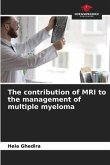Multiple myeloma is a malignant lymphoproliferative disorder of differentiated B cells, characterised by the accumulation of plasma cells in the bone marrow where they interact with bone marrow cells disrupting normal haemopoiesis and causing thrombocytopenia, anaemia, bone destruction and hypercalcaemia. Multiple myeloma is associated with the development of osteolytic bone disease, characterised by the presence of bone lesions, pathological fractures, osteoporosis and hypercalcaemia. The mechanisms by which osteolytic bone lesions occur in multiple myeloma remain unclear. Histomorphometric studies have demonstrated that bone resorption is increased in multiple myeloma; however, this is not associated with an increase in bone formation. In the later stages of the disease this results in an imbalance in bone remodelling and subsequently bone loss.
Bitte wählen Sie Ihr Anliegen aus.
Rechnungen
Retourenschein anfordern
Bestellstatus
Storno








